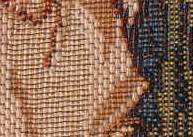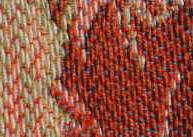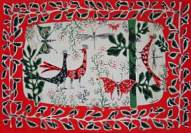|
|
 
 Tapestry weaved using Jacquard mechanism Tapestry weaved using Jacquard mechanism
They are tapestries
with continuous weft. The XIXth century is the begining time of the
mechanization: the constant vogue of the tapestry causes research. Technical
improvements, and the manufacturers try to replace expensive human labour by the
machine; The invention of the Jacquard loom then allow some manufacturers to
make fabrics imitating the tapestry. Jacquard specifies in its patent of 1801:

 "the manner the machine is moving by the means of the treadles is a great
advantage, since it results from it more celerity in the execution ".
"the manner the machine is moving by the means of the treadles is a great
advantage, since it results from it more celerity in the execution ".
On the face, the tapestries weaven by mechanical
process are recognizable by the
warp's threads which cut each thread of the visible weft. There is no
"relay" as in tapestry of discontinuous weft like those of Beauvais or Gobelins. The fabrics is made as a
one all. The weft run with no stop from one edge to the other and it is retained
 foreground by the warp which alternate fore and back at each step of the weaving
process. That warp leaves the weft visible each time needed by the motive.
foreground by the warp which alternate fore and back at each step of the weaving
process. That warp leaves the weft visible each time needed by the motive.
On the reverse of the tapestry the image appears to be negative; certain
colors seem to have disappeared; They are the parts of these threads which form
the visible drawings on the front. The threads layout are perfectly regular;
No termination of thread appears to comparare whit the Beauvais low wrap tapestry on manual loom like the one shown right hand side here.
Printed fabrics

 Others said tapestries will be made using a fabric whose warp and weft are of same color, what exclude
thus any drawing performed by the weft. Then after they will print the scenes or
the motives with a stencil key set or by silk-screen printer (using a kind of
stencil key set carried out photo-mechanically).
Others said tapestries will be made using a fabric whose warp and weft are of same color, what exclude
thus any drawing performed by the weft. Then after they will print the scenes or
the motives with a stencil key set or by silk-screen printer (using a kind of
stencil key set carried out photo-mechanically).

To justify of a "hand woven tapestry" name some manufacturers will
do not hesitate to print on a fabric weaved on a traditional manual loom but on
which the thread of the same shuttle, thread of weft thus, runs ceaseless from
one edge to the other.
The consisting result nevertheless is common printed
fabrics.
 
|
|

